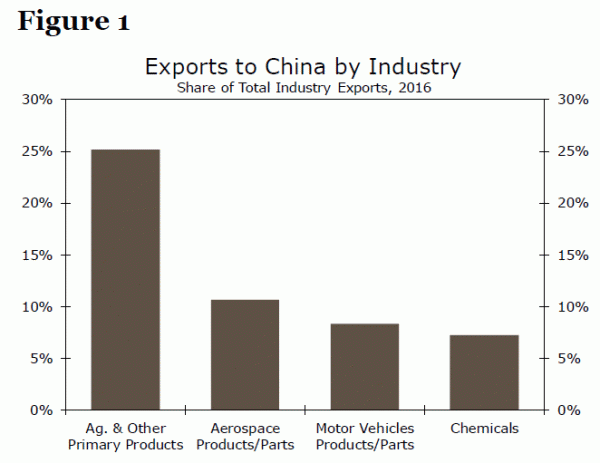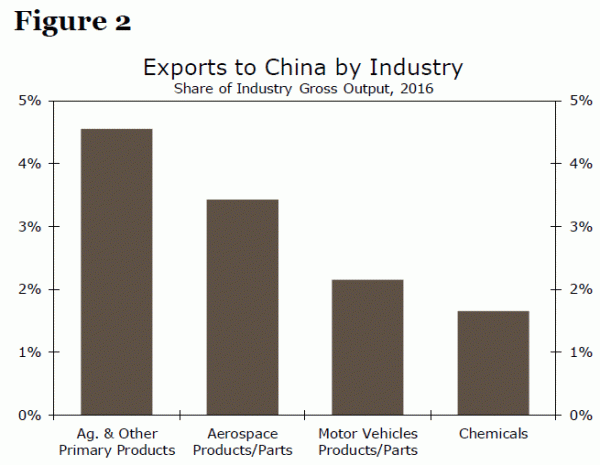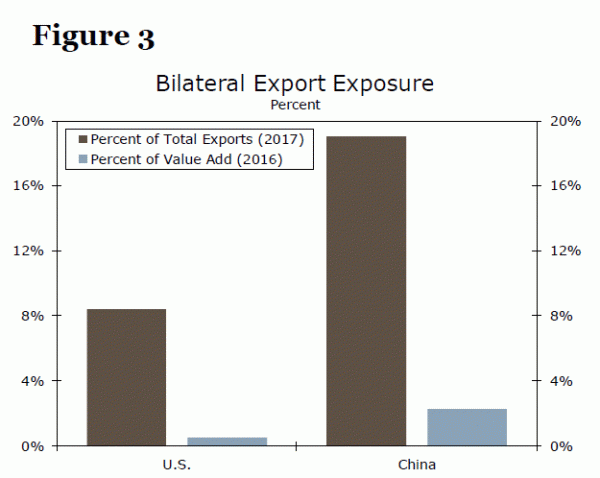Executive Summary
The United States and China have announced tariffs on each other’s goods in recent weeks. The tariffs that China has announced to date, assuming they actually take effect, would make the business environment more challenging for establishments in the agricultural, motor vehicles, aircraft and chemicals industries. But, the overall effect on the U.S. economy should be limited, at least in the near term. That said, there could be other knock-on effects that could raise the pain for the United States. A full-blown trade war, should one develop, is probably not in the best interests of the United States.
Are the Tariffs Announced to Date a “Big Deal”?
Tensions between the United States and China regarding bilateral trade have intensified in recent weeks. The United States announced in early March that it would impose tariffs on imports of steel and aluminum products. Although the tariffs were not targeted exclusively at China, the country’s exports of steel and aluminum to the United States will certainly be affected by the measures. China responded by levying its own tariffs on about $3 billion worth of American goods. On April 3, the United States announced that it would impose tariffs on the exports of about 1,300 Chinese goods, worth about $50 billion, in “response to China’s unfair trade practices related to the forced transfer of U.S. technology and intellectual property.” China promptly responded with tariffs on 106 American products—largely agricultural products, automobiles, aircraft and chemicals—whose export value to China totals about $50 billion.
These announcements notwithstanding, it may still be premature to proclaim that a full-blown trade war has commenced. After all, the proposed tariffs on Chinese goods has not yet gone into effect because they are subject to a 30-day public comment period in the United States. Depending on the outcome of the subsequent review that will be conducted by the office of the U.S. Trade Representative, some goods could be removed from the list. Likewise, China has not yet set a date on which its tariffs will go into effect. The tariffs could be completely rescinded if negotiators from both sides reach agreement on ways to settle the trade tensions between the two countries. But let’s assume that the tariffs take effect as announced. Would that be a “big deal”?
As noted above, Chinese tariffs on American goods focus on agricultural products, automobiles, aircraft and chemicals. American exports of agricultural and other primary products to China totaled nearly $20 billion in 2016, which accounted for 25 percent of the industry’s exports in that year (Figure 1).1 There were also significant amounts of exports of aircraft (nearly $15 billion), motor vehicles and parts (about $11 billion), and chemicals (more than $13 billion) in 2016. But because the total exports of these industries are larger than the total exports of the agricultural and other primary products industry, China accounts for lower percentages of their overall exports. But, all of these industries, especially the agricultural and other primary products industry, appear to have significant exposure to China.
 But when measured as a percent of total industry output, the exposure to China appears to be more manageable. For example, the gross output of agricultural and other primary products industry totaled $428 billion in 2016. Consequently, exports to China represented less than 5 percent of the industry’s output in 2016 (Figure 2). Aircraft (about 3 percent), motor vehicles and parts (2 percent) and chemicals (less than 2 percent) had even lower ratios. The exports to China of the four industries that are shown in Figure 1 and Figure 2 totaled nearly $60 billion in 2016. But, this figure represents only 2.6 percent of the output of those industries, and those industries account for less than 5 percent of all the value added that is generated in the U.S. economy. In short, Chinese tariffs on these four broad industries are not a “big deal,” at least not from a macroeconomic perspective.
But when measured as a percent of total industry output, the exposure to China appears to be more manageable. For example, the gross output of agricultural and other primary products industry totaled $428 billion in 2016. Consequently, exports to China represented less than 5 percent of the industry’s output in 2016 (Figure 2). Aircraft (about 3 percent), motor vehicles and parts (2 percent) and chemicals (less than 2 percent) had even lower ratios. The exports to China of the four industries that are shown in Figure 1 and Figure 2 totaled nearly $60 billion in 2016. But, this figure represents only 2.6 percent of the output of those industries, and those industries account for less than 5 percent of all the value added that is generated in the U.S. economy. In short, Chinese tariffs on these four broad industries are not a “big deal,” at least not from a macroeconomic perspective.
 How Painful Could a Trade War Be?
How Painful Could a Trade War Be?
But as the tit-for-tat retaliation of the past few days demonstrates, authorities in the United States and China may not stop at the measures that have been announced thus far. There could be further retaliatory steps in the days and weeks ahead. So how bad could a full-blown trade war be between the United States and China? In a worst-case scenario, each country could levy increased tariffs on all of the goods that the other country exports. How much exposure does each economy have to each other in terms of total exports?
American exports to China have shot up from $16 billion at the turn of the century to $130 billion last year. This 13 percent annual average growth rate places China among the fastest growing export markets for the United States over the past two decades. Still, China accounts for just 8 percent of total American exports at present (Figure 3). Furthermore, we estimate that the value added that is embodied in American exports to China accounts for only 0.5 percent of total value added in the U.S. economy. The U.S. economy is largely a services-based economy and most services are not exported. Consequently, exports of goods to China account for only a very small percentage of total value added in the U.S. economy.
 Looking at things the other way around, China’s exports to the United States totaled more than $430 billion in 2017, which represented 19 percent of China’s total exports (Figure 3). We estimate that these exports accounted for roughly 2 percent of total value added in China. Not only are Chinese exports to the United States significantly larger than American exports to China, but the service sector is not as important in China (in terms of overall value added) as it is in the United States. Consequently, it appears that China would have more to lose than the United States from an all-out trade war, should one develop.
Looking at things the other way around, China’s exports to the United States totaled more than $430 billion in 2017, which represented 19 percent of China’s total exports (Figure 3). We estimate that these exports accounted for roughly 2 percent of total value added in China. Not only are Chinese exports to the United States significantly larger than American exports to China, but the service sector is not as important in China (in terms of overall value added) as it is in the United States. Consequently, it appears that China would have more to lose than the United States from an all-out trade war, should one develop.
Other Potential Knock-On Effects
But, there could be other knock-on effects from a trade war that could potentially have deleterious consequences for the U.S. economy. Since March 8, when the Trump administration announced that it would levy tariffs on imports of steel and aluminum products, the Wilshire 5000 stock market index has declined about 4 percent on balance. Consequently, American households have lost about $700 billion in wealth via lower share prices. True, $700 billion is a relatively small amount in terms of the $99 trillion of net worth that American households have. But, share prices likely would decline even further if a full-blown trade war were to occur. Lower wealth could lead to slower growth in U.S. consumer spending.
Furthermore, China holds more than $1 trillion worth of U.S. Treasury securities, which represents almost 7 percent of the total marketable debt outstanding of the U.S. government. China could start to unload these securities, or threaten to do so, which could cause the price of Treasury securities to weaken significantly. The corresponding rise in bond yields could also lead to slower economic growth in the United States.
Conclusion
Whether the tariffs that the United States and China have levied on each other lead to a full-blown trade war between the world’s two largest economies is yet to be determined. The business environment would be more challenging for establishments in the agricultural, motor vehicles, aircraft and chemicals industries if China does indeed levy tariffs on those goods, but the overall effect on the U.S. economy should be limited, at least in the near term. A full-blown trade war, in which the United States and China levied tariffs on all the goods that each country exports to the other, would not necessarily bring the U.S. economy to its knees, due to the relatively small amount (in terms of overall value added) that the United States exports to China. But, there could be other knock-on effects, which are difficult to quantify, that could raise the pain for the United States. The stock market likely would weaken, which would result in a hit to wealth of American households, and bond yields in the United States could rise if China started to unload some of its sizable holdings of U.S. Treasury securities. In sum, a full-blown trade war is probably not in the best interests of the United States.














